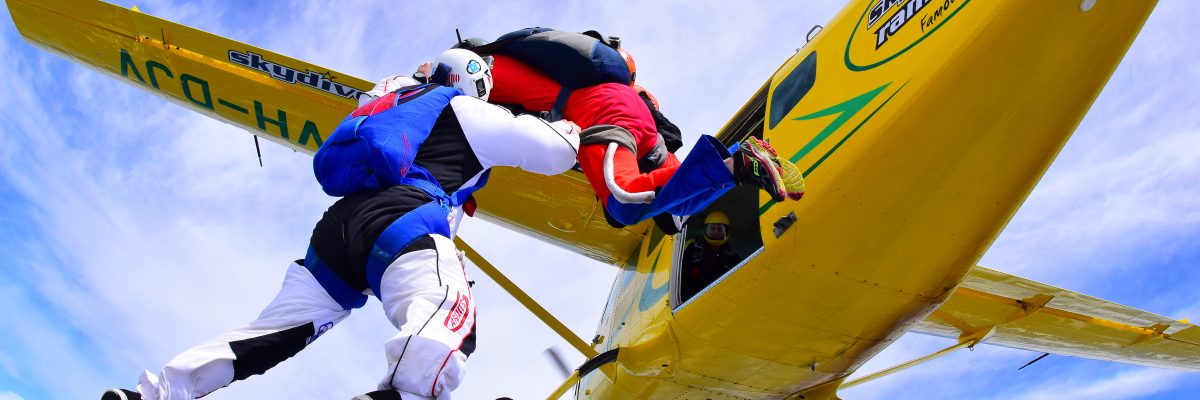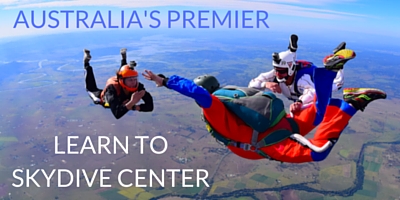- Click to Call +61 7 5423 1159
- Saturday: 8:00 am - 5:00 pm

Why Jump Out of A Perfectly Good Airplane
Saturday, May 6, 2017
- Skydive Ramblers
- 5/06/17
- 0
- General
“Why jump out of a perfectly good airplane?!,” they always ask. We think that’s not really the right question.
How about: “What happens if you stay in the perfectly good airplane?”
Okay, now we’re talkin’. Here’s the answer.
1. STAYING IN THE AIRPLANE KEEPS YOU FROM REALLY KNOWING WHAT IT REALLY FEELS LIKE TO SKYDIVE.
We’re pretty sure you’re a naturally curious person. Aren’t we right? Well: you might be surprised to know that the experience most people think they’ll have during a skydive is very different from the experience they do have.
Examples: They think it’ll feel like falling. It doesn’t. They think they’ll be scared during freefall. They aren’t. They think they’ll be overtly aware of the 120mph speed. They aren’t. They think it’ll be over in the blink of an eye. As it turns out, “skydiving time” stretches out over a startling scale.
If you stay in the airplane, you’ll never experience these things for yourself–and they are incredibly interesting phenomena.
Don’t you want to get a great big hug from the air up there? Then jump.
2. STAYING IN THE AIRPLANE PREVENTS YOU FROM KNOWING WHAT YOU’RE TRULY CAPABLE OF.
We’re also pretty sure you’re a powerful person–that, even if you haven’t been super-duper-strongly manifesting it lately, you’re capable of doing all kinds of amazing things. The little trials and tribulations of life have a tendency to make people shrink down within themselves; to chip away at their confidence to do big things and make big changes and live up to their full human capacities.
If you stay in the airplane, you won’t get the chance to experience what it’s like to feel your spirit expand to fill the whole sky.
Don’t you want to know what that feels like? Then jump.
3. STAYING IN THE AIRPLANE FORCES YOU TO BE THE SAME PERSON YOU’VE ALWAYS BEEN.
This author has said it since the very first day she tasted freefall: that once you’ve jumped out of an airplane, you’re never the same person again. It sounds crazy, but it’s true: the sea change in perspective that you get up there is a permanent thing.
Leonardo Da Vinci summarizes it best, really. “For once you have tasted flight,” he wrote, “You will walk the earth with your eyes turned skywards, for there you have been and there you will long to return.”
If you stay in the airplane, you get to be totally predictably the exact same person who walked on to the plane in the first place. Yawn.
Don’t you want to meet the person who jumps and lands? Then jump.
4. STAYING IN THE AIRPLANE ISN’T ACTUALLY THE “SAFE” CHOICE.
Statistically speaking, your car ride to and from the dropzone will be the most dangerous part of your day with us. When you get scared–which absolutely everybody does, by the way–you’re listening to the caveman part of your brain that evolved to protect you from the big bad wolf in the darkness. That part of your brain doesn’t care about stats or science or data sets. It just says “high bad! ground good!” in a grunty voice. In truth, the safety statistics that have been collected by the Australian Parachute Federation about tandem skydiving for a great many years fly in the face of your cro-magnon brain’s protests.
If you stay in the airplane, you’re capitulating to your brain’s false assumption about what is “safe” and what is “not safe,” which reinforces a very bad logical lesson.
Don’t you want to tell your brain who’s boss? Then jump.
5. STAYING IN THE AIRPLANE HOLDS YOU BACK IN SO MANY WAYS.
Don’t you want to rise to the occasion? Then jump. We’re here to make it amazing.
If you do have any concerns, read our Frequently Asked Questions page, or contact us to have a chat.

Did my AFF course here and loved every bit of it. the instructors were fantastic, I mainly had Toddy as my coach and he was phenomenal, couldn’t speak more highly of his character. It was clear that Sara and the office staff worked hard to keep everything running smoothly while i was there. Would recommend coming here to learn how to skydive!
“…loved every bit of it” – Carl Oberhofer
